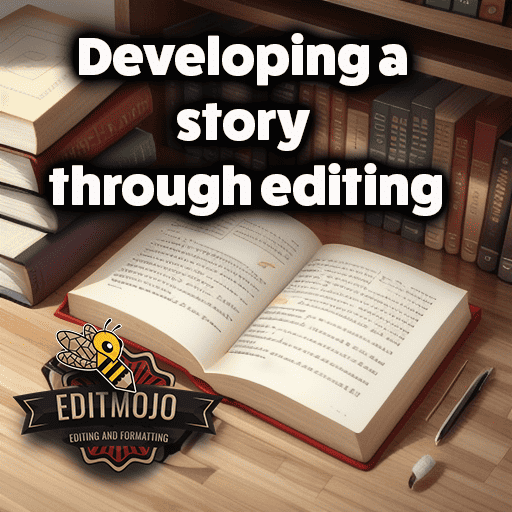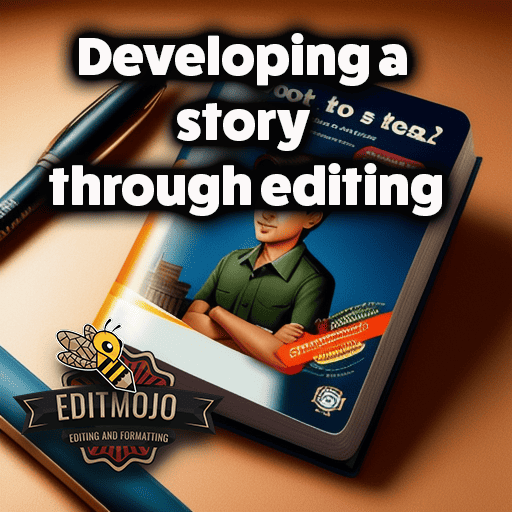Developing a story through editing
Developing a story through editing. It’s a largely unsung art, hiding in plain sight. Yet, its absence is glaringly obvious. This underappreciated craft is none other than editing, a vital process that breathes life into a story, making it engaging and immersive. In this comprehensive guide, we delve into the mechanics of editing and its role in developing captivating narratives.
Key Takeaway Table
| Section | Key Takeaways |
|---|---|
| Understanding the Basics | Editing is vital for enhancing the quality and readability of a story. It includes structural editing, content editing, copy editing, and proofreading. |
| The Anatomy of a Story | A compelling story contains key elements such as plot, characters, setting, conflict, and theme. |
| The Intersection of Editing and Story Development | Editing is integral to the development of each element of a story, helping to improve plot consistency, character depth, setting description, conflict resolution, and theme clarity. |
| Structural and Content Editing for Story Development | Structural editing improves the story’s overall flow and progression. Content editing refines the story’s coherence, character development, and plot progression. |
| Fine-Tuning the Story with Copy Editing and Proofreading | Copy editing and proofreading are the final stages of editing, ensuring clarity, style, and textual accuracy. |
| The Emotional Impact of Editing | Editing can subtly manipulate the emotional tone of the story, thereby shaping the reader’s emotional journey. |
| Editing as a Collaborative Process | A productive relationship between writer and editor can enhance the quality of the story. Tools like Google Docs and ProWritingAid facilitate collaborative editing. |
| Overcoming Challenges in Editing | Challenges in editing include preserving the writer’s voice, balancing over-editing and under-editing, and handling feedback constructively. |
Understanding the Basics
What is Editing?
At its core, editing involves reviewing, correcting, condensing, and arranging written material to improve its readability, coherence, and overall quality. The role of an editor is multifaceted, spanning from rectifying grammar errors and inconsistencies to refining the story’s structure and content.
Types of Editing
There are four main types of editing:
- Structural editing, which focuses on the story’s overall structure, organization, and pacing.
- Content editing (or substantive editing) which examines the story’s coherence, character development, and plot progression.
- Copy editing, which polishes the writing style, corrects grammar, punctuation, and syntax, and ensures consistency in terms, characters’ names, and locations.
- Proofreading, the final stage of editing, is dedicated to catching typographical errors, formatting inconsistencies, and minor textual inaccuracies.

The Anatomy of a Story (Developing a story through editing)
Storytelling is an ancient art, the roots of which stretch back to our earliest ancestors’ fireside tales. But what makes a story compelling? A story’s heart lies in its key elements: plot, characters, setting, conflict, and theme. Each element contributes to the story’s overall arc, driving it from the exposition to the climax, finally concluding in resolution.
The Intersection of Editing and Story Development
Editing isn’t a mere afterthought in the creative process; it’s an integral part of storytelling. Good editing can elevate a mediocre story into an unforgettable narrative. Let’s delve into how editing interacts with each story element.
Plot
The plot is the story’s backbone, its sequence of events. Through editing, inconsistencies in the plot can be identified and resolved, and pacing can be adjusted to maintain reader interest.
Characters
Characters are the heart of any story. Editing can help flesh out characters, making them more rounded, believable, and relatable.
Setting
The setting provides the backdrop against which the story unfolds. Editing ensures that the setting is vividly and consistently described, enhancing the readers’ immersion.

Conflict
Conflict drives the story forward. Editing aids in maintaining the conflict’s intensity and resolution, ensuring it aligns with the characters’ motivations and the plot.
Theme (Developing a story through editing)
The theme is the underlying message or meaning of the story. Through careful editing, the theme can be made more evident and resonant.
Structural Editing for Story Development
Structural editing plays a crucial role in shaping the narrative. It evaluates the story’s overall structure, assessing its flow, pacing, and progression. Successful structural editing can turn a jumbled narrative into a smooth, compelling story. Check out this insightful guide on structural editing for more details.
Content Editing for Story Development
Content editing is like a magnifying glass, allowing us to scrutinize each element closely. It evaluates the coherence and consistency of the story, its character development, plot progression, and dialogue. You can learn more about effective content editing here.
Fine-Tuning the Story with Copy Editing and Proofreading
Copy editing and proofreading are the final stages of the
editing process, each playing a unique role in perfecting the narrative. Copy editing focuses on improving the writing style and clarity, while proofreading ensures textual accuracy and consistency. You can dive deeper into these processes here.
The Emotional Impact of Editing
Editing can subtly manipulate the story’s emotional tone, shaping the reader’s emotional journey. By fine-tuning descriptions, dialogue, and character reactions, editors can amplify or dampen the emotional impact of specific scenes.
Editing as a Collaborative Process
A strong, productive relationship between the writer and the editor can significantly enhance the story’s quality. With the help of collaborative editing tools like Google Docs and ProWritingAid, writers and editors can seamlessly collaborate, exchanging feedback and ideas.

Overcoming Challenges in Editing
Editing can be a challenging process. Common issues include preserving the writer’s voice while improving the narrative, striking a balance between over-editing and under-editing, and handling feedback constructively. You can learn more about overcoming these challenges here.
Conclusion
In essence, editing is the bridge that transports a story from a raw idea into a polished narrative. It’s an integral part of the storytelling process, one that demands patience, precision, and a keen understanding of the story’s anatomy. So, whether you’re an aspiring writer or a seasoned editor, remember: every story deserves a great edit.
Further Reading and Resources
To delve deeper into the art of editing, consider exploring these resources:
- Books on editing and story development
- Online resources and tools for editing
- Writing and editing workshops, courses, and seminars
Top Five Questions and Answers (Developing a story through editing)
Q1: What is the role of editing in story development?
A: Editing plays a pivotal role in enhancing a story’s readability, coherence, and overall quality. It helps in developing each element of a story, such as improving plot consistency, fleshing out characters, refining the setting description, resolving conflict, and clarifying the theme.
Q2: What are the types of editing?
A: There are four main types of editing: structural editing (focusing on the story’s overall structure and pacing), content editing (examining coherence, character development, and plot progression), copy editing (polishing writing style, correcting grammar, and ensuring consistency), and proofreading (catching typographical errors, formatting inconsistencies, and minor inaccuracies).
Q3: How does editing influence the emotional impact of a story?
A: Editing can subtly manipulate the emotional tone of the story, thereby shaping the reader’s emotional journey. By fine-tuning descriptions, dialogue, and character reactions, editors can amplify or dampen the emotional impact of specific scenes.
Q4: What challenges might one face during the editing process, and how can these be overcome?
A: Challenges in editing include preserving the writer’s voice, balancing over-editing and under-editing, and handling feedback constructively. These can be overcome by understanding and respecting the writer’s unique style, ensuring that the essence of the story is not lost in the process, and cultivating a positive, constructive attitude towards feedback.
Q5: Why is editing often described as a collaborative process?
A: Editing is a collaborative process as it involves a close working relationship between the writer and the editor. They exchange ideas and feedback to refine the story. Tools like Google Docs and ProWritingAid facilitate this collaboration, enabling seamless communication and real-time editing.
